
Two kinds of senmaizuke pickles taught by Japanese Kyoto people.
Effective use of turnip skin!
Introducing how to pickle Senmaizuke using Kyoyasai Shogoin turnip.
Even if you don't have a Shogoin turnip, you can use a normal turnip.
This is an easy way to soak in a storage bag.
We will introduce two types of pickling, a general pickling method and a pickling method that is slightly fermented with lactic acid.
【table of contents】
1. Use the Shogoin turnip for senmaizuke
1−1. Senmaizuke season
1−2. How to distinguish between Shogoin turnip and Shogoin radish
1−3. Another story about the Shogoin turnip
2. How to pickle Senmaizuke (same taste as the shop)
2−1. Peel and slice the turnips
2−2. Tool for slicing Senmaizuke
2−3. Pickle the turnips of the Shogoin (1st stage pickle)
2−4. 2 days later (pickled in production)
2−5. Two more days later (completed)
3. Senmaizuke with a little lactic acid fermentation
3−1. 1 day after pickling
3−2. Another 3 days have passed (completed)
4. Effective use of turnip skin
5. summary
6. Explained in the video
Use the Shogoin turnip for senmaizuke
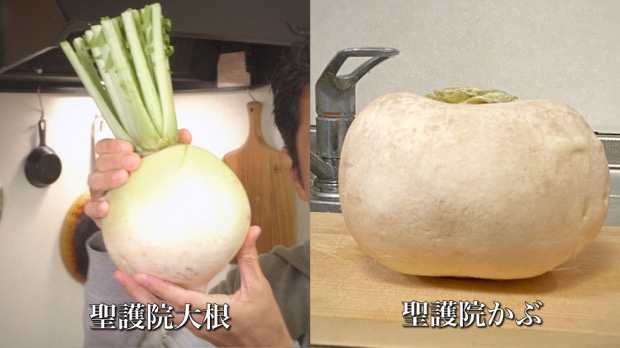
For Senmaizuke, we use the Kyoto vegetable Shogoin turnip.
If you can't get the Shogoin turnips, you can use ordinary turnips.
There are a few things to keep in mind when getting the Shogoin turnips.
There is also a Kyoto vegetable Shogoin radish, which is very similar to the Shogoin turnip.
These are very similar, but there is still the difference between radish and turnip.
Use the Shogoin turnip for senmaizuke.
Whichever pickle is pickled, it is delicious, but the fine, soft and smooth texture of Senmaizuke can only be achieved with turnips.
If you make it with radish, it will be crispy.
Most of the greengrocers in Kyoto sell Shogoin turnips and Shogoin radishes together, but the names of the vegetables are written on them, so there is no mistake if you look at them.
However, I accidentally bought the Shogoin radish and made Senmaizuke.
At that time, only Shogoin radish was sold and there were no turnips, so I bought it by mistake.
I will introduce two types of Senmaizuke from now on, but one of them mistakenly pickled Shogoin radish, but don't worry, just think of it as a Shogoin turnip.
Senmaizuke season
The Shogoin turnips are sold from November to February, so that period is the season for senmaizuke.
How to distinguish between Shogoin turnip and Shogoin radish

The Shogoin radish is the same as a normal radish, and the one closer to the leaves is a little blue.
The turnip is entirely white.
There are individual differences in shape, but Shogoin radish tends to be elongated.
Another story about the Shogoin turnip
I heard from an uncle of a greengrocer
A long time ago, when a Nagano priest came to Kyoto, brought back the seeds of Shogoin radish and started cultivating in Nagano, the climate of Kyoto and Nagano was different, so the roots did not grow and only the leaves grew and became Nozawana.
In short, it is said that Nozawana's ancestor was Shogoin radish.
So, when I looked it up, it seems to be a powerful theory that if I raised Tennoji turnips in Osaka in Nagano instead of Shogoin turnips, it became Nozawana.
It seems that there are various theories in this.
How to pickle Senmaizuke (same taste as the shop)
First of all, I will introduce how to pickle Senmaizuke, which has the same taste as the shop.
Soak in salt for 1 day, then soak in sweet and sour seasoning liquid for about 2 days.
Fermentation is not allowed.
The sweet and sour taste of Senmaizuke sold at the shop can be made as it is.
[Senmaizuke ingredients]
1 turnip of Shogoin
Salt 2% of the weight of peeled turnip
Sugar 50g
Vinegar 100ml
Mirin 50ml
Konbu 5cm
Chili > * If you can't get the Shogoin turnips, you can use any turnips.
Peel and slice turnips
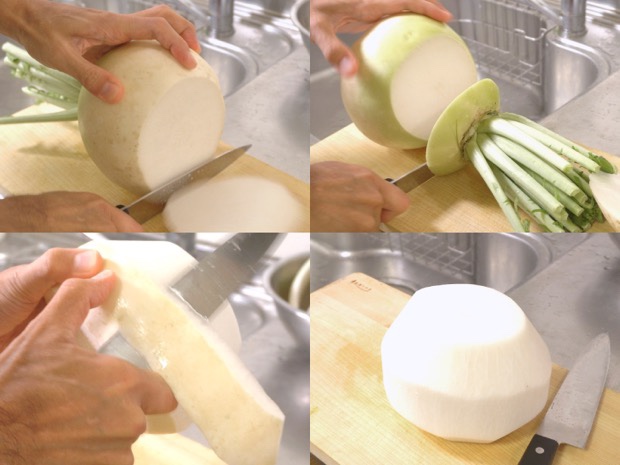
First, wash the turnips, boldly cut off the top and bottom, and then peel.
There is a little hard part near the skin to make pickles, so it is better to peel the skin thickly.
Do not throw away the skin.
It is delicious if you dry it a little and make it semi-dry and then make it kinpira.
The method will be described later.
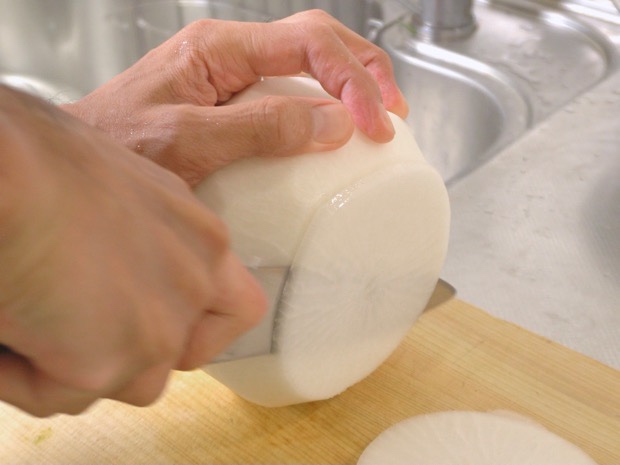
Cut this into thin slices.
At a pickle shop, you cut it into thin slices using a special tool, but at home you cut it with a kitchen knife.
It is difficult to cut this evenly and thinly, so concentrate all your nerves and cut it.
Senmaizuke is valuable because it is circular.
So I tried to slice it as round as possible.
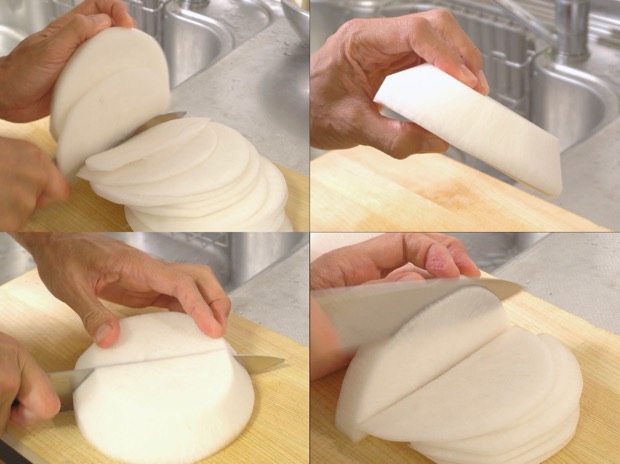
When cut with a kitchen knife, it became thick parts, thin parts, and disjointed slices that were not uniform at all.
As I cut it, it became difficult to cut the rest into a circle, so I cut it in half and sliced it into a semicircle.
After all, it is easy to cut if you make it a semicircle.
It might have been better to do this from the beginning.
Tool for slicing Senmaizuke
It's a little different story, but there is a tool for slicing Senmaizuke.
There is another tool called a slicer, but it is a slicer dedicated to Senmaizuke.

There is a store that sells it at Nishiki Market in Kyoto.
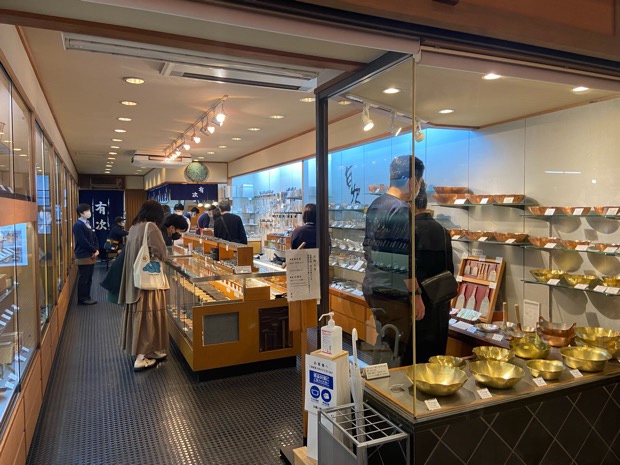
It is a shop called Aritsugu.
(1560) was founded as "Swordsmith Aritsugu Fujiwara" and has a history of more than 450 years.
Inside the store, there are kitchen knives, blades, and cooking utensils.
But I don't put the tool in the store.
When I asked the shop staff, they told me to wait for a while, and I waited for a while, but they came out from the back of the shop.
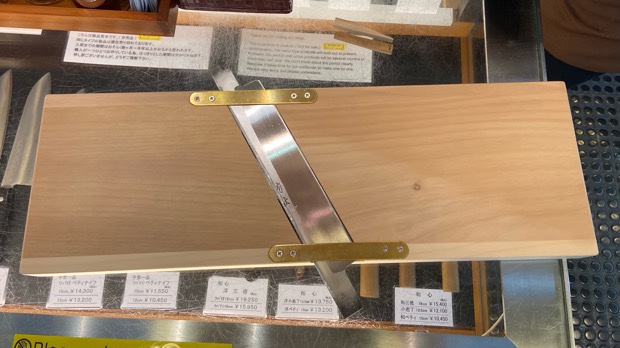
This is a tool for slicing Senmaizuke.
The width is, of course, wide enough to cover all Shogoin turnips, so it's quite big.
You can adjust the thickness of the slice by hitting a wedge between the blade and the main body.
Of course, you can sharpen the blade for maintenance, so you can slice Senmaizuke semi-permanently.
And the price is 38,500 yen (tax included).
I wanted it, but it was expensive, so I came back without buying it.
With this tool, you will be able to make senmaizuke slices at home like those sold at stores.
Pickle the turnips of the Shogoin (1st stage pickle)
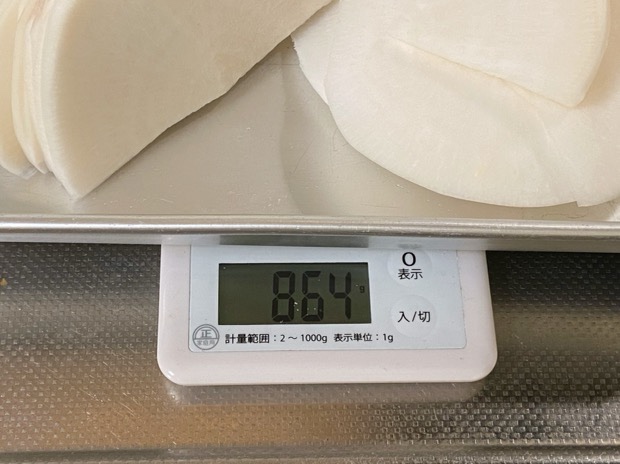
The peeled turnip weighed 864g.
On the other hand, soak in 2% weight of salt.

I prepared 17g of salt.
18g is fine.
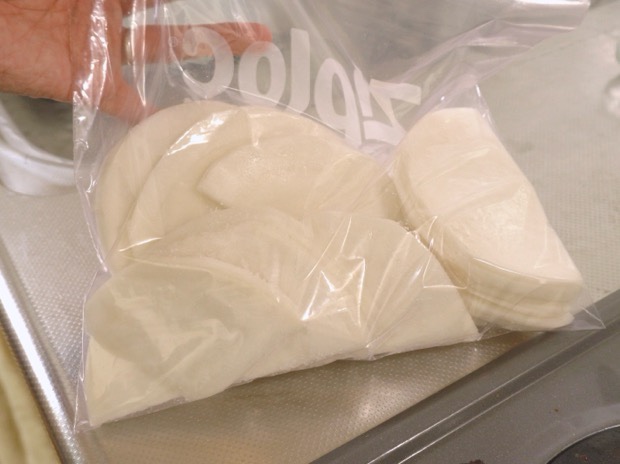
Put turnips and salt in the bag, deflate the air in the bag as much as possible, and close the lid.
At this time, I did not mix the inside of the bag and sprinkle salt on the whole.
Even if the salt is solidified in one part, the water will come out from the turnips, and the water mixed with the salt will gradually spread throughout, so the whole will be soaked in the end.
To make the whole soak, make sure to deflate the bag.
If the air is properly removed, the water from the turnips will spread throughout, and you can expect the same effect as if you put a heavy stone on it and pickle it.
And leave it as it is for one day.
2 days later (pickled in production)
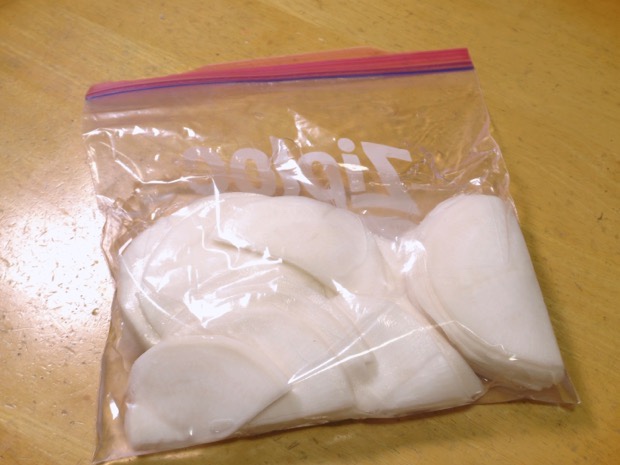
After all, I left it for two days.
On the first day, I got home late, so I didn't do anything on that day and ended up leaving it for two days.
It doesn't mean that you have to leave it for 2 days.
One day or two days is fine.
Moisture comes out, the turnips are soft and soaked properly.

Drain the water.
At this point, it is better to drain the water well so that it tastes good.
The taste of the seasoning liquid soaks in well when it is pickled.

[Seasoning liquid]
Sugar 50g
Vinegar 100ml
Mirin 50ml
Kelp 5cm
Chili pepper

Fill the bag with all the ingredients for the seasoning liquid, deflate the bag and close the lid.
You don't have to mix and dissolve the sugar.
It melts on its own.

Put it in a vat and leave it in the refrigerator for about 2 days so that it is okay if water leaks.
Two more days later (completed)
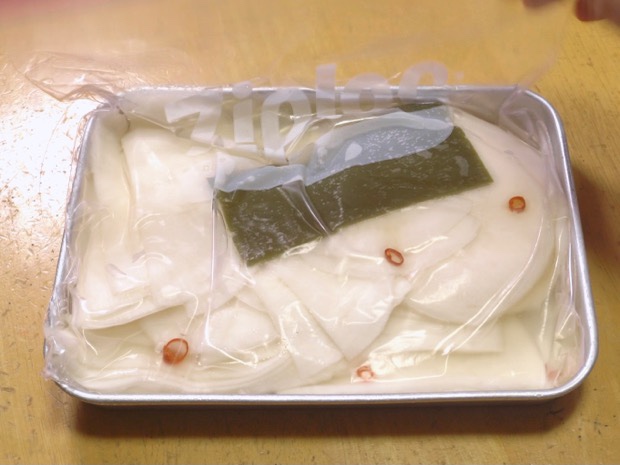
It must have been soaked in the taste.
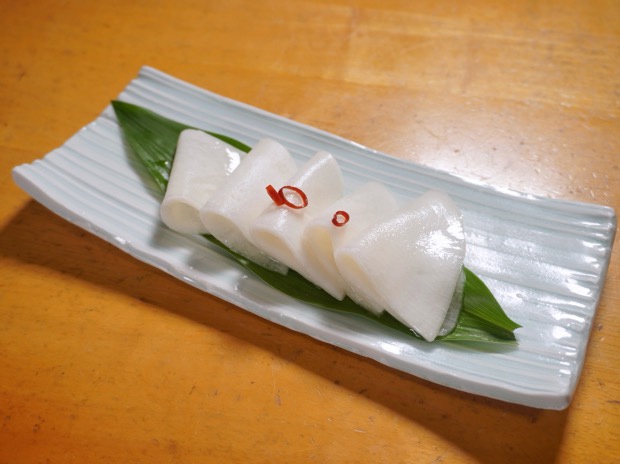
Serve on a plate.
Sweet and sour, refreshing, turnips are soft, smooth, delicate and delicious.
It has the same taste as Senmaizuke sold at the store.
Even if one big turnip was pickled, it wasn't left over, and the four family members ate it immediately.
Senmaizuke with a little lactic acid fermentation
The method I'm going to introduce will have a different taste than the one sold in Senmaizuke.
Because it is fermented with lactic acid, the acidity of the fermentation comes out.
It is a pickle with plenty of lactic acid bacteria that is gentle on the stomach.
【Senmaizuke ingredients that are slightly lactic acid fermented】
Shogoin turnips 1 piece
Salt 2% weight of radish
Chili pepper
Kelp appropriate amount
It is the same up to the point of peeling and slicing the turnips of the Shogoin.
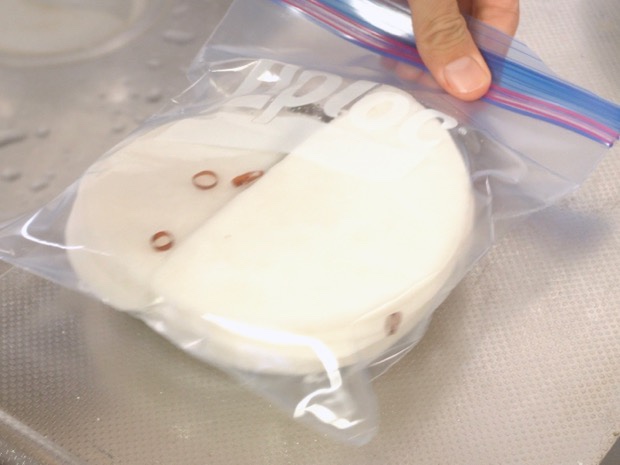
Put all the ingredients in the bag.
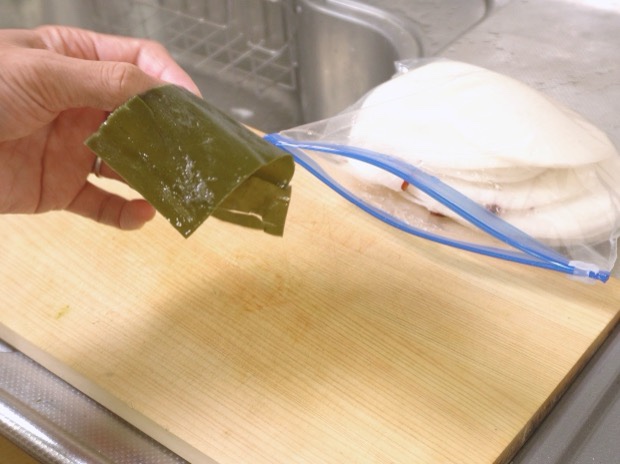
After leaving it for about 5 minutes, remove the kelp.
Because the kelp absorbs the moisture of the turnip and becomes soft.

Chop the kelp.
The kelp can be chopped or not chopped.

Add kelp, deflate the bag and close the lid.
Leave it at room temperature as it is.
If it's winter, it's a good idea to keep it in a warm room with heating.
If you put it in the refrigerator, the speed of lactic acid fermentation will slow down, so it is better to keep it in a warm room.
漬けてから 1日後
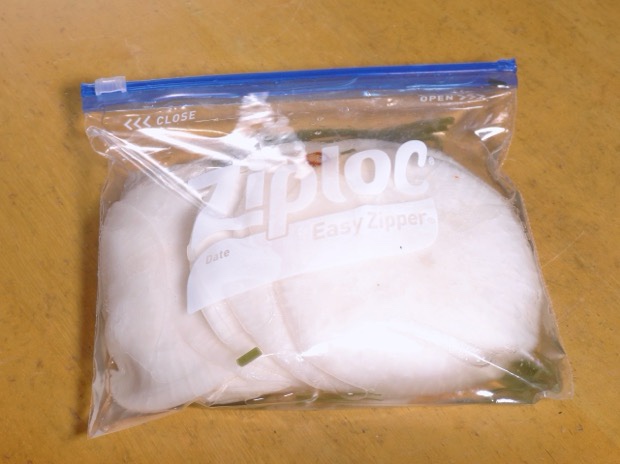
It's been a day.
It's already soaked and water is coming out.
It is delicious enough to eat at this point, but if you leave it at room temperature and ferment it with lactic acid a little, the acidity and umami will come out and it will be more delicious.
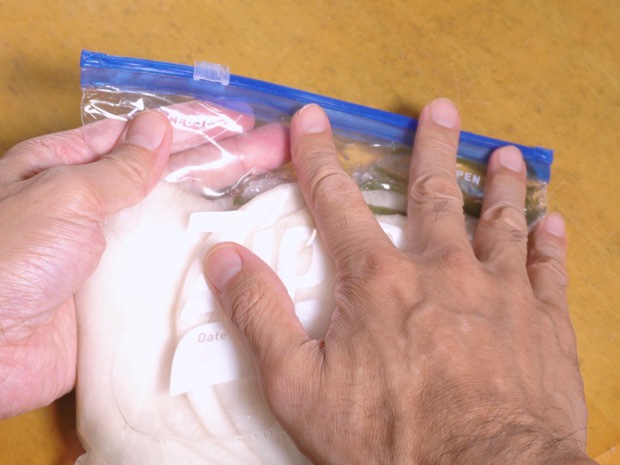
Hold the bag to bleed the air.
Try to keep as little air as possible in the bag. When it was just pickled, the turnips were hard, so air remained in the gaps, but after pickling it for a day, it became soft, so try not to leave air in the gaps as much as possible.
Please note that if there is a lot of air left in the bag, it will cause mold to grow.
Another 3 days have passed (completed)
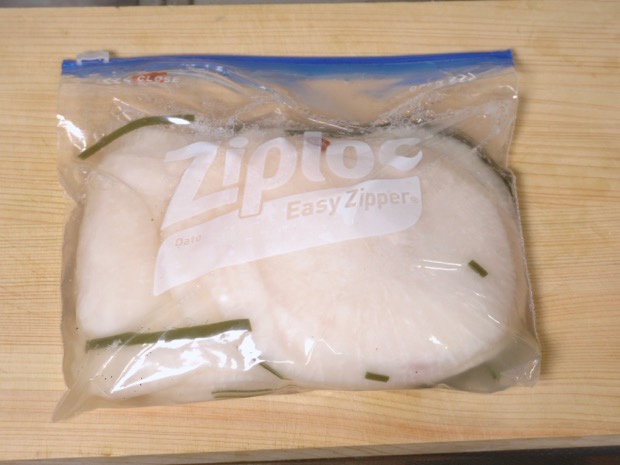
It's soaked in a nice feeling.
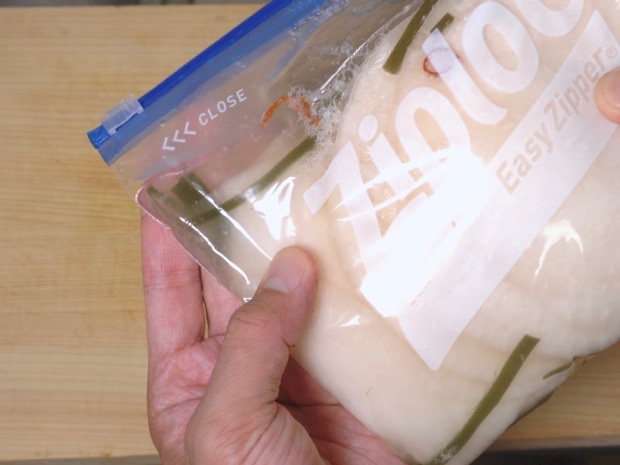
Can you see that the pickled juice is a little cloudy?
This cloudy sign is the start of lactic acid fermentation.
In the case of Senmaizuke, it is delicious enough with just a little turbidity.
By the way, since the Shogoin turnips are available in winter, they can be placed in a warm room in winter in 4 days, but if they are soaked in the same way in summer, lactic acid fermentation will start in 1 day.
The period until fermentation starts changes depending on the temperature, so if the pickled juice becomes a little cloudy, please judge that it is time to eat.
When it's time to eat, you can extend the period of time to eat by putting it in the refrigerator and slowing down the fermentation.

Senmaizuke with a little lactic acid fermentation.
It is delicious with the acidity and umami produced by fermentation.
There is no sweetness.
お漬物の乳酸菌は、生きて腸まで届くので体に良いですよ。
If you sprinkle soy sauce on it, it will be delicious again.
Effective use of turnip skin
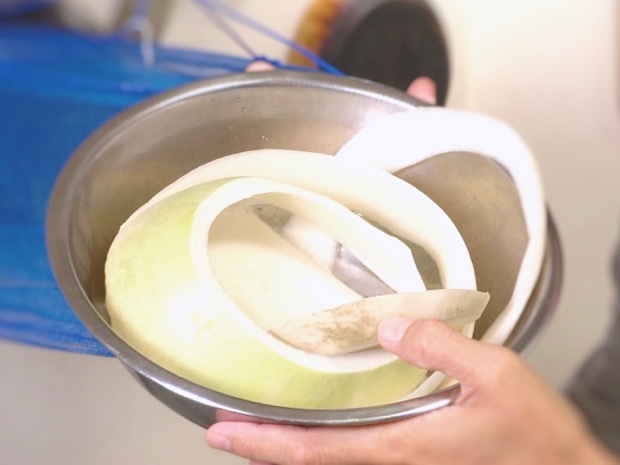
This is a peeled leather.
It is delicious if you dry it a little to make it semi-dry and then chop it into kinpira.
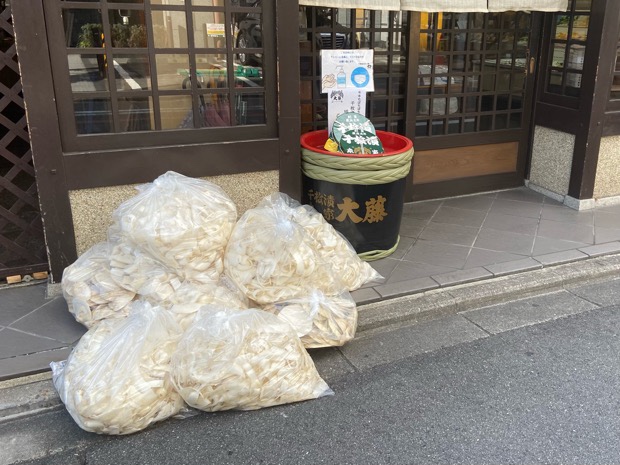
The pickle shop throws away this skin.
In winter, you can see the skins packed in bags piled up in front of the pickle shop.
This is also a winter tradition in Kyoto.
It's a waste, so I thought I'd take it and eat it at home.
However, the amount was too large to implement.
However, I would like to make effective use of the skin that occurs at home.

Put it in the net and dry it on the balcony.
Even if you don't have a net, you can place it so that it doesn't overlap with a colander or a plate.
It doesn't have to be on the balcony, but indoors.
In the case of indoors, it is better to have a well-ventilated place or a place where the air conditioner blows.
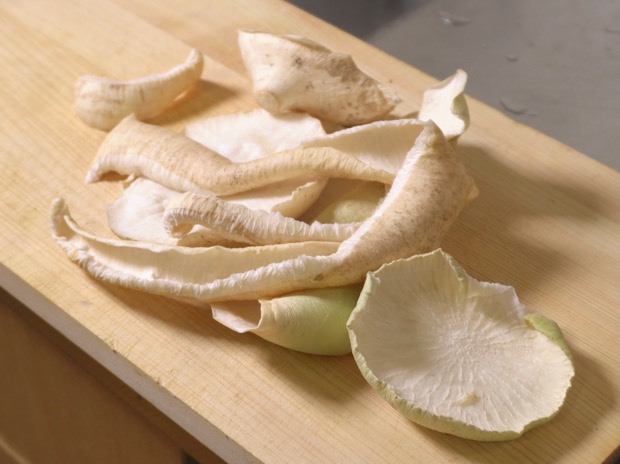
The skin was dried for 2 days.
Two days in the cold season of November.
The weather was nice.
Under such conditions, it became semi-dry to this extent.
I think it's just the right feeling to make it kinpira.
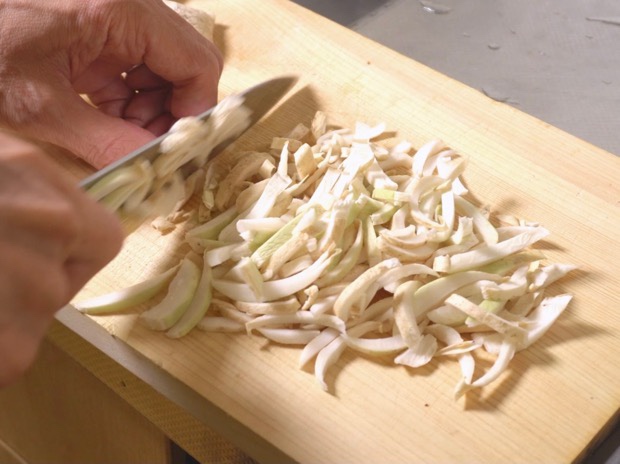
Cut this into julienne.
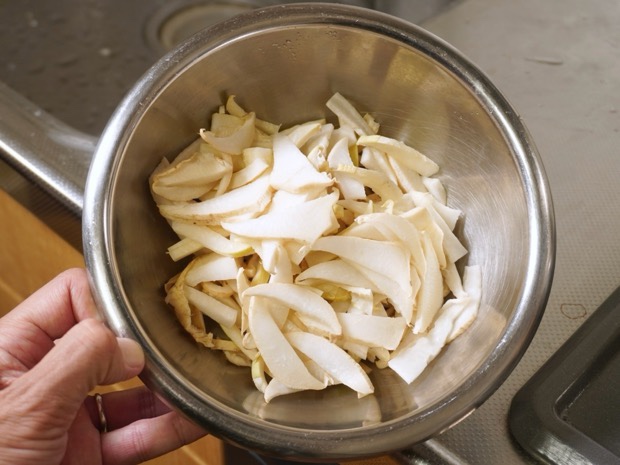
After cutting everything, it looks like this.
【Kinpira seasoning】
Appropriate amount of soy sauce
Appropriate amount of Shichimi or Chili pepper
Appropriate amount of sesame seeds
Sesame oil a little
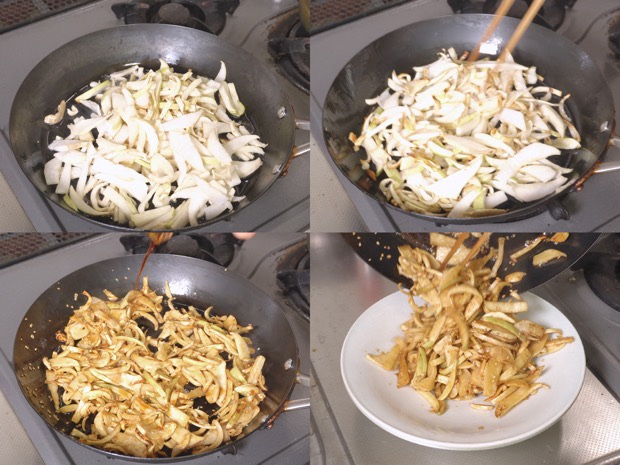
Heat a frying pan, add oil, and fry the chopped skin.
Vegetables usually become soft when stir-fried, but when they are semi-dried, they do not change much when stir-fried.
Therefore, it is difficult to judge whether it is cooked or not.
You can eat it even if it's not cooked very much, but I think it's better to stir-fry it carefully.
When you think it's cooked, add soy sauce, shichimi, and roasted sesame seeds and mix.
To finish, turn off the heat and add sesame oil to complete the process.
Serve on a plate.
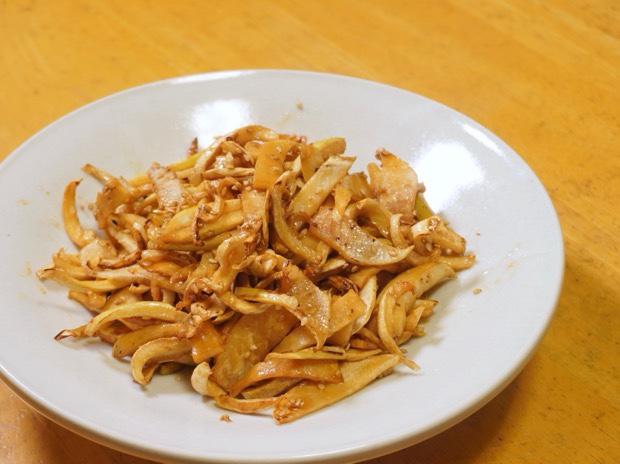
Kinpira of the skin of the Shogoin turnip.
The taste of turnip is condensed and it is delicious with the flavor of sesame.
If it's so delicious, I'll do my best to pick up the skin from the pickle shop and make a lot of it.
I'm just thinking.
Summary
- For Senmaizuke, use the Kyoto vegetable Shogoin Kabu.
- Be careful not to mistake the Shogoin Kabuto and the Shogoin Daikon.
- There is a special tool for slicing Senmaizuke.
- The handmade Senmaizuke is delicious.
- A little lactic acid fermentation is good for your health.
- The skin is delicious when it is semi-dried and kinpira.
Explained in the video
There are two videos about Senmaizuke.
otokonakamura talks passionately.
There are some things that can only be told in the video, so please have a look.
↑ This is a type that is slightly lactic acid fermented.
I mistakenly pickled it in Shogoin radish, but please think that it is pickled in turnip.
I will also introduce how to make kinpira of skin here.
↑ This is how to pickle Senmaizuke, which has the same taste as the shop.
Introducing how to see Shogoin radish and turnips, and a slicer for Senmaizuke.
